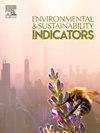A comparative study on energy use and environmental impacts in various greenhouse models for vegetable cultivation
IF 5.4
Q1 ENVIRONMENTAL SCIENCES
引用次数: 0
Abstract
The aim of this study was to compare energy consumption and damage assessment in different types of greenhouse structures used for vegetable production. The research focused on analyzing energy indicators in the production of greenhouse products, specifically Tunnel and Quonset greenhouse structures growing cucumber, tomato, and eggplant in Shushtar city. Data was collected from greenhouses with both types of structures, as well as from a random field survey of 20 greenhouses in the city. The results showed that energy consumption in Tunnel greenhouses for cucumber, tomato, and eggplant crops was 4.35 × 106, 3.85 × 106 and 3.33 × 106 MJ ha−1 respectively. For Quonset greenhouses, the energy consumption for the same crops was 4.86 × 106, 4.36 × 106 and 3.85 × 106 MJ ha−1, respectively. The energy efficiency for each crop and greenhouse type was also calculated. The study found that Quonset greenhouses had higher energy consumption compared to Tunnel greenhouses, with cucumber crops showing the highest energy consumption. The highest yield was achieved with cucumber crops in Quonset greenhouses, while the lowest yield was seen with eggplant crops in Tunnel greenhouses due to differences in structure dimensions. Environmental effects analysis revealed varying levels of pollution caused by resource usage, with eggplant production in Quonset greenhouses showing the highest pollution levels. Recommendations were made to optimize electricity, diesel fuel, and fertilizer use to reduce energy consumption and environmental impact. The study suggested the adoption of renewable energy sources like solar power to mitigate energy consumption in greenhouse production.
求助全文
约1分钟内获得全文
求助全文
来源期刊

Environmental and Sustainability Indicators
Environmental Science-Environmental Science (miscellaneous)
CiteScore
7.80
自引率
2.30%
发文量
49
审稿时长
57 days
 求助内容:
求助内容: 应助结果提醒方式:
应助结果提醒方式:


